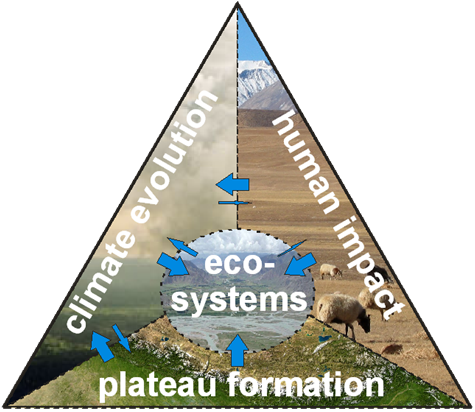Master Thesis
Carbon budget of Kobresia pasture as dependend on grazing intensity
Johannes Ingrisch (06/2010-11/2011)
Support: Yakov Kuzyakov
Geoökologie, Univ. Bayreuth
Keywords: 13 CO 2 pulse labeling, alpine Kobresia pygmaea pasture, C allocation, C turnover, Qinghai- Tibetan-Plateau, grazing, eddy covariance measurements
The grassland soils of the Qinghai-Tibetan-Plateau (QTP) store substantial amounts of carbon (C). In recent decades the management of grazing as the dominant land use changed, but the impact on the C sequestration is uncertain. For the evaluation of possible effects detailed understanding of the C cycling in these ecosystems is essential. In this work we investigate C stocks and allocation of recently assimilated C in the plant-soil-atmosphere system by in situ pulse labeling at an alpine Kobresia pygmaea pasture. The study was conducted at Kema research station (4400 m a.s.l.) on the QTP during the summer of 2010. Three grazing treatments, which had been established one year before the experiment (normal grazing, livestock exclosure, total grazing exclosure) were investigated. No differences in terms of belowground C stocks and fluxes of recent assimilates were obtained between the grazing treatments. Therefore, data was pooled for further analysis. More than 99% of the C stored in the ecosystem is located belowground in roots and soil organic carbon (SOC). The minor contribution of aboveground biomass is also reflected in a large root:shoot ratio (R:S=76). At the end of the chase period (2 months) only 9% of recovered 13 C were incorporated in shoots. The largest proportion of 13 C was recovered in belowground CO 2 efflux (37%). Especially during the first days the recovery of 13 C in the CO 2 efflux was high, which refers to a rapid turnover of assimilates in root and rhizomicrobial respiration. 29% of recovered 13 C were incorporated into roots, whereas the recovery in SOC was small (6%). The amount of 13 C in roots declined in the second half of the chase period, which is a result of decomposition of labeled roots. A part of this labeled C was incorporated into SOC leading to the slight increase of 13 C recovery in the SOC over the chase period. The roots have a mean residence time of 25 days, as estimated from the efflux rate of 13 CO 2 . The partitioning of assimilates in the system was coupled with eddy covariance measurements that were conducted at the study site during the experiment. Thereby we are able to obtain not only the relative distribution of assimilates but also to calculate absolute fluxes of C in the plant-soil- atmosphere system. In conclusion, we provide a characterization of the C budget and dynamics of C allocation for an alpine Kobresia pygmaea pasture which is representative for large parts of the Qinghai-Tibetan-Plateau.

